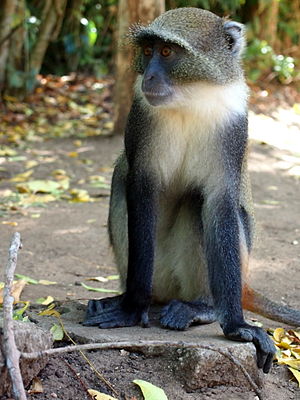White-throated monkey
| White-throated monkey | ||||||||||||
|---|---|---|---|---|---|---|---|---|---|---|---|---|

White-throated monkey ( C. a. Albotorquatus ) in Kenya |
||||||||||||
| Systematics | ||||||||||||
|
||||||||||||
| Scientific name | ||||||||||||
| Cercopithecus albogularis | ||||||||||||
| Sykes , 1831 |
The white-throated monkey ( Cercopithecus albogularis ) is a species of primate from the genus of the monkeys ( Cercopithecus ) within the family of the vervet monkeys (Cercopithecidae). The species has long been considered a subspecies of the diademed monkey ( Cercopithecus mitis ), but in many more recent classifications it is given the status of a species.
features
White-throated monkeys have a gray coat, the back is more or less olive yellow, the tail, the arms and the outside of the legs are blackish, but the inside of the legs are gray. The name-giving feature is the wreath of white hair in the throat and neck area. The chin in the otherwise dark face is also white. With a head body length of 26 to 68 centimeters (males) or 20 to 65 centimeters (females), a tail length of 31 to 95 centimeters (males) or 26 to 85 centimeters (females) and a weight of 2.7 to 11, 1 kilogram (males) or 1.3 to 6 kilograms (females), the species is extremely variable in terms of size, with the males becoming larger than the females.
distribution and habitat

White-throated monkeys are native to large parts of eastern and southern Africa. Their highly fragmented distribution area extends from southern Somalia through Kenya , Tanzania and Mozambique to South Africa . In the north, the Rift Valleys separates the range of the white-throated monkey from that of the black-throated monkey, and in Zambia the Luangwa , the white-throated monkey occurs to the east and the black-throated monkey to the west. The habitat of the white-throated monkeys are tree-lined areas, mainly forests.
Way of life
Not much is known about their way of life, presumably it corresponds to that of the diademed monkeys. As a result, they are diurnal tree dwellers and live in groups of 15 to 40 animals. These consist of a male, several females and their offspring. White-nosed monkeys mainly feed on fruits, but they also eat leaves, flowers, bark, seeds, tree sap and small animals.
Systematics
Within the genus of monkeys ( Cercopithecus ), the white-throated monkey belongs to the mitis group, which also includes the diademed monkey and the great white-nosed monkey . Numerous subspecies are distinguished in their large area of distribution. In the following, only those subspecies are listed that are recognized in both the Handbook of the Mammals of the World and in the Mammals of Africa . The colors named after the distribution areas refer to the distribution map on the right.
- Cercopithecus albogularis albogularis , (southern coast of Kenya, northeastern Tanzania, Zanzibar (olive)),
- C. a. albotorquatus , (northern coast of Kenya, gallery forests along the Tana (dark blue)),
- C. a. erythrarchus , (in southern Malawi , in central Mozambique and in easternmost Zimbabwe (orange)),
- C. a. francescae , (in northern Malawi (gray)),
- C. a. kolbi , ( highlands of Kenya (purple)),
- C. a. labiatus , (eastern and southeastern South Africa (brown)),
- C. a. moloneyi , (Zambia east of Luangwa , southwestern Tanzania, extreme north of Malawi (red)),
- C. a. monoides , (eastern Tanzania (light blue)),
- C. a. zammaranoi (southeastern Somalia in the gallery forests along the Juba and Shabelle (pink)).
The Handbook of the Mammals of the World lists two other subspecies: C. a. kibonotensis (southeastern Kenya, Kilimanjaro , Mount Meru in Tanzania) and C. a. phylax ( Lamu Archipelago ). In the Mammals of Africa, these are synonymous with C. a. albogularis or from C. a. albotorquatus .
Danger
In parts of their range, they have become rare due to hunting and the destruction of their habitat. The population of the Somali subspecies C. a. zammaranoi is estimated at only 200 to 500 specimens and it is considered to be critically endangered. The distribution area of C. a. Kolbi is to a large extent within protected areas ( Aberdare National Park , Mount Kenya National Park ). Overall, the white-throated monkeys are not endangered species.
literature
- Thomas Geissmann : Comparative Primatology. Springer-Verlag, Berlin et al. 2003, ISBN 3-540-43645-6 .
- Don E. Wilson, DeeAnn M. Reeder (Eds.): Mammal Species of the World. A taxonomic and geographic Reference. Johns Hopkins University Press, Baltimore MD 2005, ISBN 0-8018-8221-4 .
Individual evidence
- ↑ a b c d Elizabeth L. Gadsby, Colin P. Groves, Aoife Healy, K. Praveen Karanth, Sanjay Molur, Tilo Nadler, Matthew C. Richardson, Erin P. Riley, Anthony B. Rylands, Lori K. Sheeran, Nelson Ting, Janette Wallis, Siân S. Waters & Danielle J. Whittaker: Family Cercopithecidae (Old World Monkeys). Pages 693-694 in Russell A. Mittermeier , Anthony B. Rylands & Don E. Wilson : Handbook of the Mammals of the World: - Volume 3. Primates. Lynx Editions, 2013 ISBN 978-8496553897
- ↑ a b Michael J. Lawes, Marina Cords & Cathi Lehn: Cercopithecus mitis, pages 354-362 in Jonathan Kingdon, David Happold, Michael Hoffmann, Thomas Butynski, Meredith Happold and Jan Kalina (eds.): Mammals of Africa Volume II: Primates , Bloomsbury, London, 2013 ISBN 978-1-4081-2252-5
- ↑ Cercopithecus mitis ssp. zammaronoi in the endangered Red List species the IUCN 2008. Posted by: Mitter Meier, RA & Rylands, AB (Primate Red List Authority), 2008. Accessed February 19 2017th
- ↑ Cercopithecus mitis ssp. albogularis in the endangered Red List species the IUCN 2006 Posted by: T. Butynski & Members of the Primate Specialist Group, 2000. Accessed June 24 of 2008.
